Our first contact with Caballito Cerrero came several years ago, at our annual Mezcal Reviews Party. The celebration marks the anniversary of the launching the Mezcal Reviews website, and it coincides nicely with Mexican Independence day in September. We typically have 6-8 pre-selected flights, on which we gather feedback, and there are usually another 15-20 bottles floating around on other tables for guests to sip and discuss throughout the evening. Here’s a blog post about our most recent anniversary party (Covid has interrupted us since, but we’ll have our 6th Anniversary Party this year): Mezcal Tasting: 3rd Anniversary Party
While certainly not expected, guests will occasionally bring a bottle for sampling from their own collection. And that’s exactly what happened. The room was alive and full of conversation when William Scanlon and Philipp from Heavy Metl Imports entered the main tasting room. These are two of our favorite agave heads in Austin, and we both made our way over to them through the bustling crowd. We greeted them with two copitas, and they unexpectedly greeted us with an ensamble of Jabali-Tepextate from Rey Campero (which at the time had not yet been released) and a bottle from a brand that we’d never heard of.
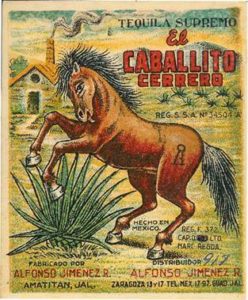
The older Caballito Cerrero branding used on their bottle.
“This is one of the most well-respected tequila brands in the world,” William told us. “You’re going to love this stuff.” He handed me the bottle: Caballito Cerrero. I opened it, put my nose to the top, and inhaled. It was like nothing I’d ever smelled before. Totally pure blue agave aromas.
Unfortunately, William and Philipp were double booked that night so they couldn’t stay long, but word of the Caballito Cerrero bottle spread quickly throughout the party, with everyone wanting to get a taste. It was a smashing debut. Almost all of the bottle was devoured before the night was finished, and it was the first ever tequila to really stand it’s ground with our Austin-area mezcal heads.
New Labelling and The US Brand Launch
By the time Caballito Cerrero first landed in the US in January of 2019, there was already a large group of both tequila and mezcal fans that were eager to scoop it up. The big twist, however, was that the first batches to land in the US (and all of them since) were not certified as tequila. Similar to mezcal, which has the Consejo Regulador del Mezcal (CRM) to certify spirits made in certain regions and under certain parameters, tequila has the Consejo Regulador del Tequila (CRT) to certify what can legally be called tequila. The team at Caballito Cerrero had chosen to forgo the CRT certification. We’ll get into that more later.
In addition to the spirit name changing from tequila to destilado de agave, the labels had also changed from a very colorful, yet waxy-looking label to a clean black-and-white label with the image of a wild horse that has a Fabio-like flowing mane. I was instantly interested and went to my favorite retail shop, The Austin Shaker, as soon as I heard that the bottles had dropped. I entered the store and was greeted by Paul Dutton, who is another local agave head, renowned for his agave knowledge and inability to drink red wine ;). On the shelf were several bottles of Caballito Cerrero Azul and one bottle of Chato.
“What the hell is Chato?” I asked Paul.
“Not sure,” he said. “The bottle says it’s an Angustifolia. We got one bottle of Chato mixed in with the Azul.”
Naturally, I bought the only bottle of Chato, and was once again blown away by the flavors inside. The brand was thoroughly entrancing.
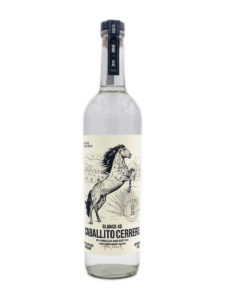
The new labels and branding that landed in the US.
Amatitán, Jalisco
Many consider Amatitán the birthplace of the spirit of tequila. We’ve been told that the town of Tequila, which is just down the road from Amatitán, was where the Spaniards made their spirits, but Amatitán was for the local people. While we can’t speak to the validity of that claim, we can tell you that there’s a very, very long history of agave spirits production in this region. It’s an area rich in cultural and familial heritage.
Unfortunately, Covid greatly delayed our first trip to the area. It wasn’t until May of 2022 that we were able to spend time there. Our plan was to visit as many non-tequila producers in Jalisco as possible. With so much destilado, raicilla, etc… happening in Jalisco, there’s a lot more happening in spirits production than may meet the eye of the typical tequila drinker. Naturally Caballito Cerrero was at the top of our list.
We’d been warned that it was very difficult to get out to see Caballito Cerrero. The distillery is just outside of town but incredibly difficult to access. Also, the two members of the family who continued the tradition of distilling, Javier Alfonso Jimenez Teran and his father Javier Alfonso Jimenez Vizcarra, are both full-time attorneys in Guadalajara. Thankfully, just as the Heavy Metl team had first introduced us to the brand several years before, they were able to introduce us to the family to ensure that we’d be able to make the visit.

The road through the family’s agave fields, down to the distillery.
Early Pickup
Javier and his father picked us up at our AirBnB in Guadalajara at 7:30 am sharp. Tyler didn’t have enough Electrolit in his system and forgot to mention there were four of us, so there weren’t enough seats in the truck. Javier told us that he’d lay down in the bed of the truck and get some more sleep while we piled into the cab. His father was driving.
Amatitán is on the way to the town of Tequila, so the road was great. After about 45 minutes, we turned off the main highway, down another paved road, and eventually through a small passageway to a cobblestone street that was lined with lush bluish-green agaves for as far as one could see. We’d entered their family’s land, a 700 acre parcel that had been passed down for generations, and is currently used primarily for forestry and agave cultivation. The agaves are used both in their own production, as well as sold to bigger tequila brands for spirits outside of what the family is able to produce.
The cobblestone road continued down into a large canyon for about 20-30 minutes, descending several hundred feet down toward a river at the base of the steep canyon. We drove past the current distillery, the Santa Rita Fabrica, and Javier’s father made a turning motion with his hand to signify to the men outside the distillery that he was going to return shortly. We continued down the sharp slope and over a bridge that traversed the river at the base of the canyon. We parked on the other side of the bank and got out of the truck.
“This is the old distillery,” Javier told us.
The Caballito Cerrero UNESCO Site
In the early 2000s, the UNESCO organization was doing research into ancient distillation sites throughout Mexico. They travelled the country visiting many sites, dating them, and logging them for historical purposes. In 2006, UNESCO certified the ancient distillation site of Javier’s family as the oldest archaeological site of agave distillation existent in Mexico, dating back to at least the year 1600.
There are certain places you visit, where you can really feel the history and age of a place. You can feel the energy and the emotion that is locked into that unique corner of space. Javier’s family’s ancient distillation site is one of those places. You can feel the history of the place and the blood, sweat, and tears that have been shed there. This is the Stonehenge of agave spirits production.
The old site is situated on a slope just above the river. There is a fully intact pit oven near the highest point of the production site. Javier mentioned that they may try to re-use the oven at some point to make a special batch, which would be pretty exciting. There’s a tipped tahona on it’s side in the middle of a circular ring of stones just below the pit oven on the hill. There’s also a few other broken tahonas in other areas of the site that Javier explained had been destroyed as part of failed ancient efforts to steal them.
Below the cooking and milling areas, there are dozens of fermentation pits carved into the stone of the hillside. The hours and labor needed to carve these fermentation pits, likely by hand, is unimaginable. Remnants of a distillation house also reside further down the slope, near the river. It’s an incredible site to see, a beautiful location on it’s own, even without the historical aspects of several hundred’s of years of agave spirits production.
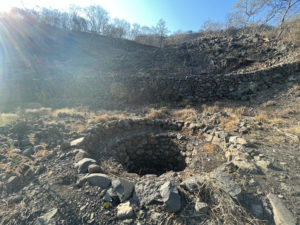
The ancient pit oven used to roast agave hundreds of years ago.
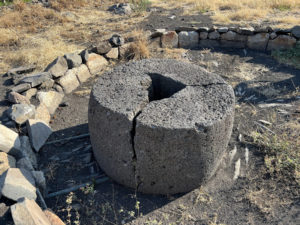
The ancient tahona used to mill the cooked agave.
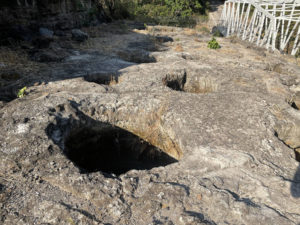
The fermentation pits that are carved into the stone of the hill.
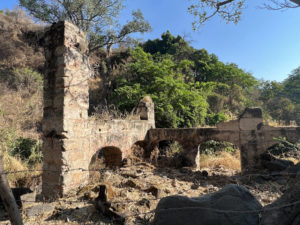
The remaining ruins from the old distillation area.
Javier, his family, and UNESCO posit that the ancient production site was used for a little over 200 years before production was moved across the river to it’s current location. When asked why the family stopped using the old site, he said that it was likely a feud over access to the water needed for production.
The road that we took to get there, which passes through both the current and archaeological distilleries, wasn’t built until 1950. Before that, Javier’s grandfather used to take horses to the nearest road almost everyday to sell their spirits. This was a 2 hour journey by horseback. While the road was a little bumpy in a truck, our travel was nothing compared to the journey it took to get back to the main road just 70 years ago.
The Santa Rita Fabrica
We jumped back into the truck and drove back across the river in the direction from which we’d arrived. Javier’s father waved to the men outside the distillery gate. They opened the doors and let us inside.
The Santa Rita Fabrica, which is the current distillery, was built in 1873. Everything about the distillery was designed to use gravity as the driving force of production. For example, there are aqueducts from further upstream, further up the canyon slope, that channel fresh cold water throughout the distillery. This is beneficial for use in the milling, fermentation, and distillation processes. It also provides an incredible ambience as the sound of falling water permeates the entire brick building as the aqueducts channel and divert fresh water to each step of the production process.
In addition to the aqueducts, the steam ovens were also designed with an element of gravity to ease the production process. All three of the ovens used in production load from the top. When you enter the distillery, you’re actually on the roof, as the distillery is built on the side of the canyon. Trucks hauling agave can easily dump their agaves on the roof. From there, the agaves are dropped down through doors in the roof, into top-loading steam ovens.
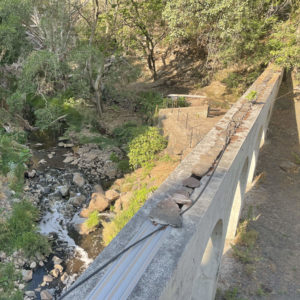
An aquaduct with water running from further upstream and higher on the hill to channel water into the distillery.
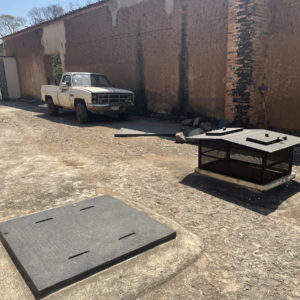
The entrance way that doubles as a loading area for the top-loading ovens. Agave is loaded in through the black metal door on the ground, from which it drops into the steam oven.
Once cooked, the agaves are loaded onto a conveyor belt to be mechanically crushed. Once crushed, they are added to open-air steel fermentation tanks, where they ferment with the naturally occurring yeasts for around 7 days. Before the use of the steel fermentation tanks, cement fermentation pits existed in the floor of the distillery, similar to the stone fermentation pits that had been used at the archaeological site for several hundreds of years. After fermentation, gravity once again leads the agave to a lower area for distillation. They do the first distillation in steel and the second distillation in copper.
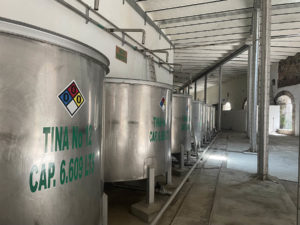
The stainless steel fermentation tanks used at the current Santa Rita distillery.
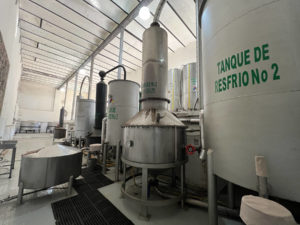
The distillation area at the current Santa Rita distillery.
Current Production
As mentioned, Javier and his father (as well as his uncle) are all attorney’s in Guadalajara. So while the Caballito Cerrero brand is one of the most well-respected tequila, and now destilado, brands in the world, it’s not a full time gig for anyone in the family. Javier is a 15th generation producer. For perspective, we’re generally impressed by 5th generation producers when we visit Oaxaca. That’s lineage!! 15th generation is unheard of. Their family has been producing agave spirits for a long, long time. Their history is seen in both Caballito Cerrero, but also Herradura Tequila, which Javier’s side of the family split from in 1950 over some sort of family dispute.
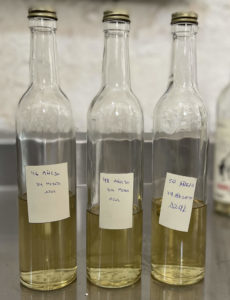
Tasting an Azul Anejo proofed at different levels at the distillery.
Given their current occupations, it’s not possible to distill full time, as the family has done in years past. The current generations are keeping the tradition alive, but that means only distilling two times per year. Their desire to use only capon agaves may also be a limiting factor in the frequency and size of production. For Caballito Cerrero, 20 tons of agave will equate to around 1600-1800 liters of destilado. They’re only producing a few thousand liters a year by choice. Once the distillation is complete, they proof each batch into releases that are bottled at 40%, 46%, and 50% ABV (and if you’re lucky/crazy they also bottle some very limited 70% ABV puntas).
These limited runs allow them to truly focus on their family’s history, the traditional processes, and the product they eventually bottle for the market. It’s truly extraordinary. They currently only use agaves that are grown on their land, which include maguey Azul (Agave tequilana) and maguey Chato (Agave angustifolia). While they received 9 or 10 Kentucky whiskey barrels in the 1970s, which they use for some aging, most of their spirits are bottled unaged. Javier mentioned that it’d be a fun project to eventually work with Espadin or Cenizo, but those are agaves they’d need to purchase, which is something they aren’t currently doing.
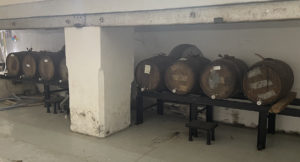
Caballito Cerrero doesn’t always age their destilado in wood, but when they do, they age it in Kentucky whiskey barrels.
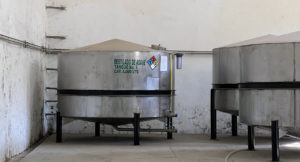
The majority of their production ends up resting in these steel containers before being bottled.
No Longer Tequila
Both Javier and his father were passionate when speaking about their decision to stop using the term tequila to describe their spirits. They stopped using the word tequila in 2018. Destilado de Agave was a better fit as they saw that the CRT was too restrictive.
Javier’s dad and uncle were part of the team that was building the CRT in the early 1990s. Keep in mind, they are attorney’s with a rich history of agave spirits production in their family. Who better to write the laws governing what can and can not be called tequila? They had a clear vision for what tequila should be and they wanted to ensure that the spirit stayed pure. With this as their driving motivation, they made several recommendations and adjustments to the originally proposed CRT documentation. Most of these recommendations were to protect the consumer as well as to ensure that tequila production would be an ethical and just practice for future generations. Unfortunately, the governing party decided not to include these recommendations in the final legal documents. This quickly disillusioned the family, so they formally left the group that was establishing the CRT, but still kept using the word tequila on their bottles until 2018.
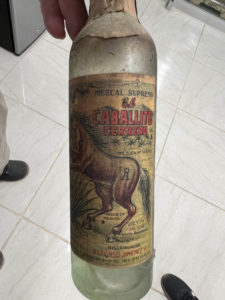
An extremely old bottle of Caballito Cerrero that is kept in a library-type room that houses the family’s production history. Notice that the label refers to mezcal.
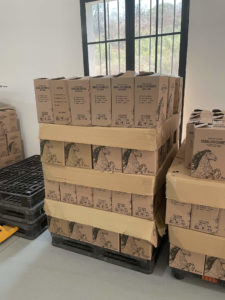
Fresh cases that are ready to be shipped.
The Family, The Tradition
For us, the visit to Caballito Cerrero was monumental. They’re a pinnacle brand and production family globally and a model for everything that is great about Jalisco and the rich history of tequila. This is something they’ve had to fight to protect as well. At one point, they were sued by another big company that claimed rights to the name Caballito Cerrero. Again, they are a family of attorneys, so they were able to fight for the trademark that they registered in 1950, but it took about 10 years to clear the name. The case went all the way to the supreme court in Mexico.
The family has been there since the very beginning. What impressed me most about Caballito Cerrero was the pride that both Javier and his father had in their family and the traditions that have been passed down through 15 generations. Even with obligations to other industries and job functions, they’ve found a way to keep the core of the family tradition alive.
Their tradition is the history of tequila, of agave production, of the Amatitán region. They represent so much to the area, the culture, and to the history of one of the most revered spirits in the world. What they produce now is limited, but they’re deeply passionate about it. Javier’s son, who is only a small child, already comes down to the distillery when they are producing. He and his cousins are the next generation, the 16th generation.


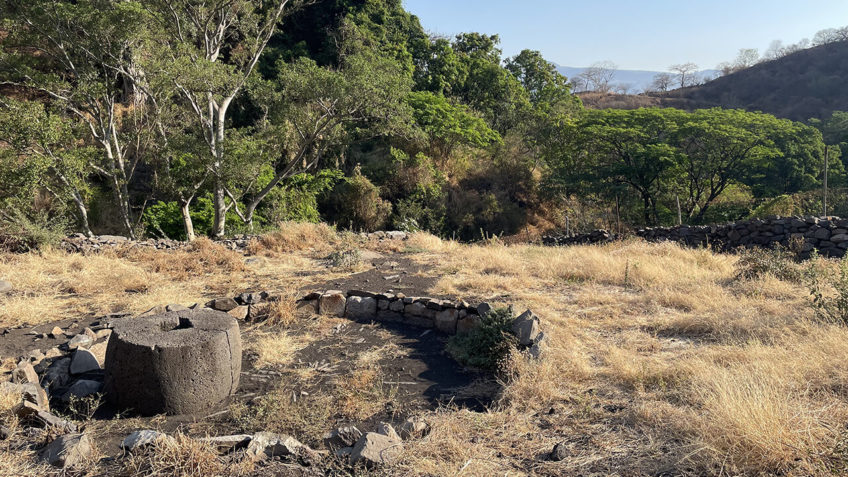
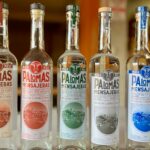
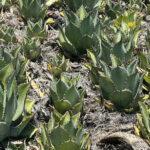
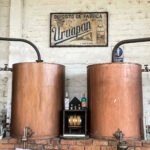
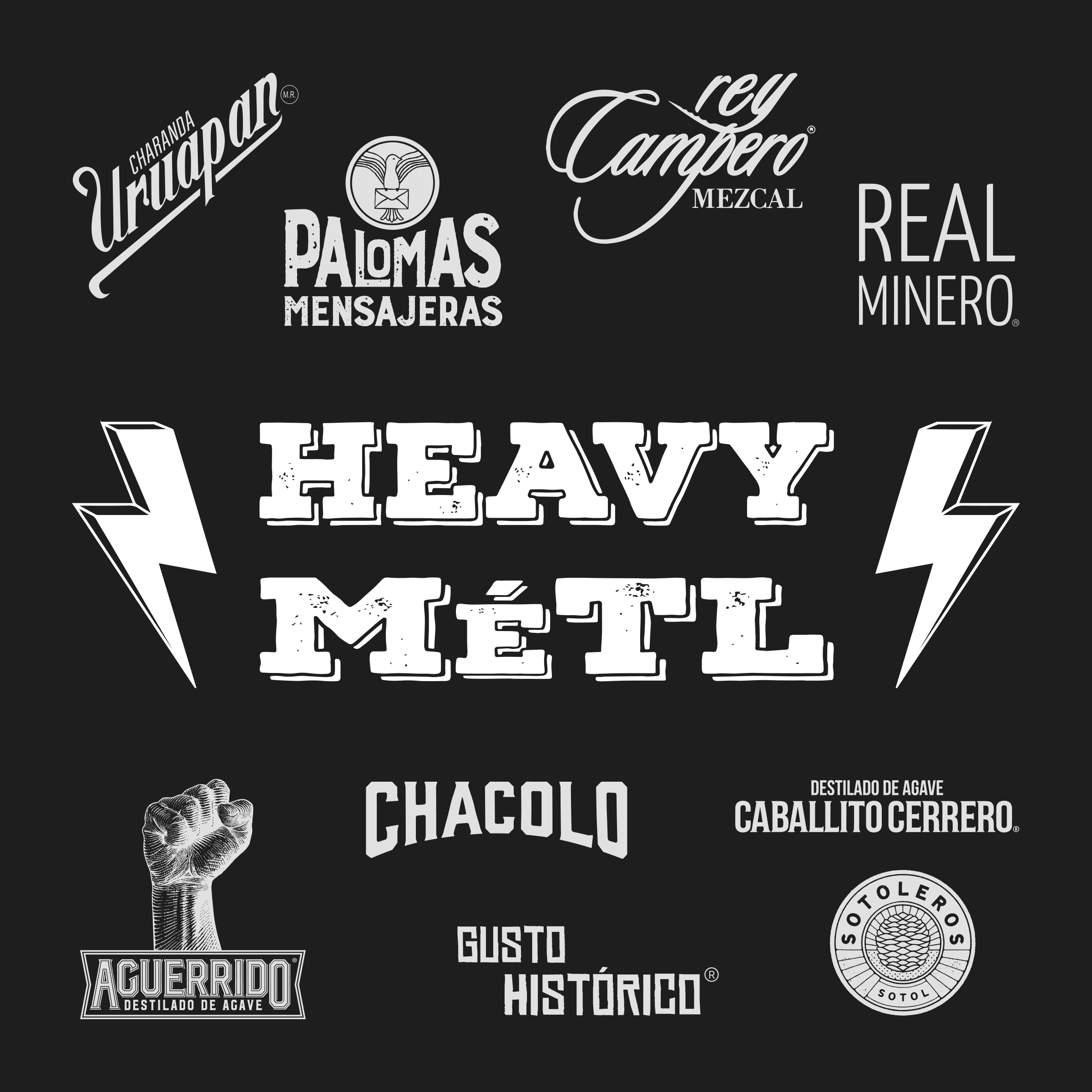
Phil Bolton
3 months agoGreat read.
Kevin
1 year agoWhat a terrific post, terrific adventure! Here is the history lesson I never had in school, while I slept through one after the next monotone lecture. Here is the culture and the story.
Great work Jonny. Thank you so much.
Greg Logan
2 years agoWOW!! All I can say is this is fascinating… and certainly VERY little known.
I was intrigued because a couple years back I had somehow run into this – cannot remember how – and managed to get a bottle of Azul and Chato. I have a great fondness for the Chato – earthy – unique. Both with a LOT going on – and worth the price. I expect to pick up another bottle of Chato when I have a chance.